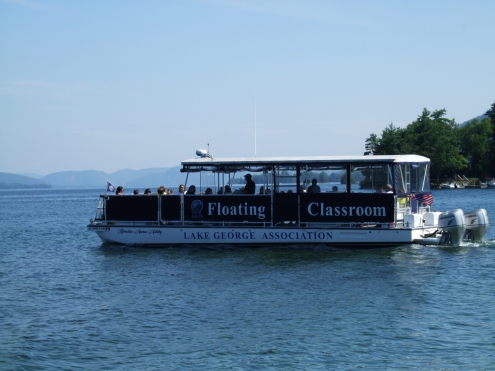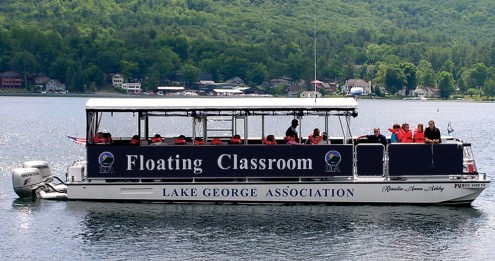
Dean Moore, (pictured at left), and Josh Davis, both from the Warren County Soil and Water Conservation District, conduct a bathymetric survey of the delta at Hague Brook. Standing more than 150 feet from shore, Josh is measuring water depth (here about three feet) while Dean notes the GPS location. This survey produces a map of the depth of the water at various points on the delta, and helps the LGA access the volume of sediment that would potentially need to be removed, in this case about 27,000 cubic yards (over 5,000 dump trucks full!)
The Lake George Association is moving forward with a long-term effort to remove several deltas on the Lake. The LGA is examining alternative methods for dredging deltas located at the mouths of three major brooks on the west side of the Lake: Finkle brook in Bolton, Hague brook in Hague and Indian brook in Bolton. The LGA has spent years examining these watersheds and working on upland projects on these brooks.
“With any project of this magnitude a number of partners and steps are required,” said Walt Lender, executive director of the Lake George Association. “This week we completed the public comment period for the development of the scope of a Supplemental Environmental Impact Statement. Essentially, this is the first round of opportunity for public input on the general scope of the proposal. Next we will complete a draft detailing exactly how and what we propose to do, and the public will have a longer period to comment on that – usually a minimum of 30 days,” he added.
The Department of Environmental Conservation, in accordance with the State Environmental Quality Review Act (SEQRA) requires impact statements to be prepared and presented to the public for comment before a project like this can be implemented. The original environmental impact statement, covering all deltas on the lake, was approved back in 2004 by the Lake George Park Commission. In this statement only two methods of removing the sediment in the deltas were discussed: 1. conventional mechanical removal from a barge, and 2. hydraulic removal. Preparation of a supplemental impact statement to this original statement became necessary because now the LGA would like to examine alternative methods for dredging. The supplemental statement will also address the environmental impact of these other methods. The particular methods detailed in the supplemental statement are:
1. Mechanical dredging from access pads. The access pads would be constructed from dredged material;
2. In-water mechanical dredging; and
3. Suction dredging.
“We want to arrive at a definitive solution for removal of these deltas: one that we all can live with and one that is vetted through an open public process,” said Randy Rath, LGA’s project manager. “The deltas are certainly a result of damage caused by human interaction with the watershed, and it is up to us to reverse this damage. We just need to agree on what the best, most environmentally appropriate method will be,” he added.
The LGA has successfully completed similar dredging projects on Lake George, most recently the 2009 project at Foster Brook in Huletts Landing. This project greatly improved navigation, removed 1500 cubic yards of sediment, and largely restored the lake bottom. The fishery has greatly benefited, as the smelt started running again in the brook in 2010, after years of not running. Working behind a double set of turbidity curtains, the contractor completed the work in less than two weeks.
“We are very sensitive to the environmental risks that are inherent in these projects, and we painstakingly apply numerous measures to protect the sensitive ecosystem and maintain water quality,” said Walt Lender, LGA Executive Director. “On projects where the LGA has been involved, we have witnessed remarkable contrasts between the water in the project area and the water in the main lake on the outside of the turbidity curtains. We keep the water in the main lake clear and contain the stirred up water within a series of carefully installed and maintained rows of sediment curtain. Before removing the curtains, we give the water in the project area sufficient time to settle out. Once it’s clear we remove the curtains,” he said.
At Finkle Brook (Bolton), the LGA, and its project partners, expect to remove approximately 8,000 cubic yards of sediment over a roughly three-acre area. At Hague Brook, plans call for removing approximately 27,000 cubic yards of material from an approximately ten-acre area. And at Indian Brook (Bolton), removing approximately 25,000 cubic yards of sediment over an approximately eight-acre area is proposed.
On each one of these delta dredging projects, the LGA has asked the municipalities to certify that identified upstream problem areas are remediated, and the municipalities have passed resolutions in support of the projects. On Hague Brook, two sediment retention ponds were created, through the joint efforts of the LGA, the Warren County Soil and Water Conservation District and the town of Hague. By slowing down the velocity of the water in the streams, these sediment ponds allow the sediment to drop out, preventing it from going into the Lake and adding to the deltas. Creating and maintaining sediment ponds is much easier, much less expensive, and much less complex than removing deltas.

This map created using data from the bathymetric survey of the Hague Delta shows water depths at one-foot intervals (green lines), and their distance from the shoreline. The project proposes to dredge this delta up to a four-foot depth (the blue line). (This image was created by the LGA from a map supplied by the Warren County Soil and Water Conservation District.)

















